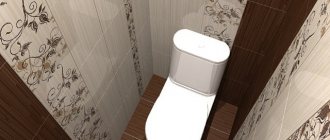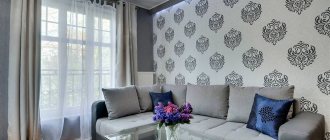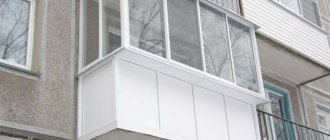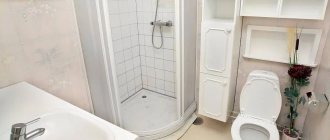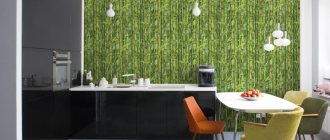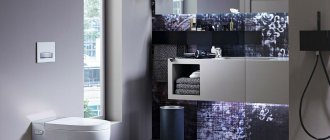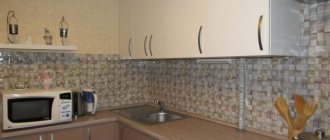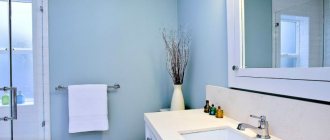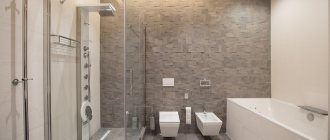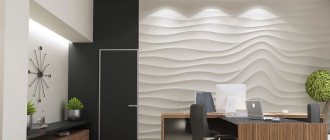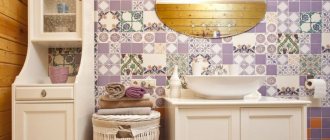Photo: neuesbad.de “Lucky” to become the owner of a Khrushchev building with all the ensuing consequences? Do you think you can turn it into something comfortable and beautiful? It will succeed, and we are ready to help! We suggest that you don’t put things off for too long and start right away with the most difficult part: the bathroom! We have already selected several ideas and proposals for its design.
General recommendations
Bathrooms in Khrushchev buildings have common features:
— Combined small bathroom. So you will have to look even more carefully for plumbing fixtures and furniture;
— Problems with ventilation and dampness. This means that you need to avoid any cracks and unnecessary seams, which could potentially become a favorable place for the development of mold and mildew. Try to choose the most monolithic structures possible, and do not forget about antiseptic treatment;
— All Khrushchev-era communications date back to the 80s at best. If you have the opportunity to completely replace the pipes, do not refuse it. Repair work will be much more difficult and expensive in the future;
— It’s difficult to find a place even for the necessary supplies. Give up useless decor. Instead, choose original soap dishes, glasses, coasters, heated towel rails and other useful little things.
Stages of repair work - step by step
This section of the article will discuss the stages of repair work with a brief description of their implementation. After studying this information, you can determine whether you can reconstruct the premises yourself, or whether it is better to invite professionals.
So, a few words need to be said about the features of bathrooms in houses built by Khrushchev, which have not been subject to redevelopment or major repairs for a long time, sometimes even since the start of their operation.
A bathroom in a Khrushchev building may have this original appearance. And this is not the most terrible thing you’ll ever encounter...
As a rule, the walls of the room are still covered with Soviet-era tiles, the surface of which is covered with small cracks and chips, and some finishing elements have completely fallen off. The towel dryer is an ordinary steel pipe, bent into a U-shaped loop, which is connected to the riser with unsightly welds that often leak.
Do you need this window? Considering it as an “escape route” is ridiculous, and there is no saving on lighting, given the current variety of LED devices.
The wall separating the bathroom and the kitchen area is equipped with the notorious, incomprehensibly necessary window, which many owners previously covered with frosted film or, after removing the glass, covered the opening with plywood.
Pipes can be scary to touch - often with the slightest effort they simply crumble into dust
As a rule, water supply and sewerage pipes look horrifying. Sometimes, when dismantling them, they simply fall apart in your hands, since during operation their internal parts have become thinner due to corrosion and have lost all strength.
The plaster of the walls, especially in their lower part, under the constant influence of moisture, lost its strength and began to peel off and crumble, so dirt constantly appears on the floor in the form of a cement-sandy wet mass.
If the bathroom is in this condition, then a major overhaul is simply necessary. In order to save money, repair work can be done with your own hands by selecting materials with affordable prices, which are abundant in construction stores today.
| Illustration | Brief description of the operations performed |
| Bathroom renovation begins with shutting off the water supply. Then comes the rather dirty and hard work of freeing the space from worn-out plumbing accessories. The dismantled bathtub, toilet and sink are removed from the room and usually melted once into scrap, otherwise other work will be very difficult. | |
| The next step is to clean the surfaces of the walls and floors from old tiles or other decorative coverings. The tiles are easily removed using a hammer drill, into which a special chisel attachment is installed. There is no such tool - you can remove it manually. Usually this stage of work does not cause difficulties and goes quickly. True, there will be plenty of garbage, and so will the hard work of transporting it to a landfill. | |
| If you plan to level the walls using ordinary “wet” plaster, then after removing the decorative coating, it is recommended to apply notches on the surface. Most often, notches are made using an ax. The old coating, as well as debris generated during the application of notches, should be immediately removed from the room, since deposits of bags will become a serious obstacle to the further process of arranging the bathroom. | |
| Next, the water and sewer pipes are dismantled. Quite often, after assessing the condition of the main sewer section, it is necessary to remove it completely. To carry out this work, you will have to make peace and come to an agreement with the lower and upper neighbors, since the new pipe will need to be cut into the common house main, and the connection of the riser elements, as a rule, is located just below the ceiling surface or 200÷250 mm above the floor. When a pipe is removed, a through hole will necessarily form in the floor slab, which will subsequently need to be sealed. In any case, it is best to change the entire riser at once. | |
| If the hole turns out to be wide, then after installing the pipe, installing the formwork below, you will have to fill it with concrete mortar. Small gaps remaining around the pipe can be easily filled with foam. It is important to correctly calculate the installation height of the tee in the new riser, with the help of which the toilet and drain pipe will be connected to it - the line from the bathroom, sink and kitchen sink. | |
| The next step is to replace the water pipes. The old wiring is completely removed and a new one is installed, for which metal-plastic or polypropylene pipes are most often used. | |
| If you plan to hide all the “beauty” of the wiring, then grooves are cut into the wall, in which the pipes will be hidden. It is necessary to deepen the pipes so much that their outer side is located at least flush with the main surface of the wall. If in the future the surface is planned to be leveled with plasterboard sheets, then when cutting channels for installing pipes, it is necessary to take into account the thickness of this “dry plaster” (12 mm), that is, the grooves should not be made too deep. The process of replacing any pipes is quite complicated for a beginner, and if there is no experience in plumbing installation, then it would be better to invite an experienced specialist who will make a reliable tight connection of both the sewer riser section and the water supply pipes. | |
| If you plan to install a washing machine in the bathroom, or simply increase the number of sockets by distributing them in different places, then for installation of wiring in the surfaces of the walls and ceiling, grooves are also installed. You won’t have to scratch the floor slab if the design includes a suspended ceiling that will hide all the unsightly electrical wiring. For fire safety purposes, all electrical cables should be enclosed in a special corrugated insulating tube. | |
| Before moving on to the next stage of work, the surfaces of the room should be strengthened with a deep penetration primer with an antiseptic effect. The composition is applied using a roller in two and sometimes three layers, each of which requires good drying. Well, if old spots of mold are clearly visible on the walls, then you will have to first carry out “treatment” with potent compounds, then thoroughly clean these spots, and then perform priming. | |
| If the bathroom walls are in poor condition, you will have to work on them, leveling them with plaster or “dry plaster” (plasterboard). If you choose the simpler, second option, then you must choose exclusively moisture-resistant drywall and attach it directly to the wall using a special mounting adhesive. Some craftsmen use polyurethane foam with a low expansion coefficient to fix sheets. The use of this technology for installing drywall is possible if the unevenness of the walls is no more than 20 ÷ 30 mm. | |
| When leveling the walls, a box is usually immediately installed to cover the vertically located riser pipes. If the communication lines are already located in a niche, then it is also recommended to cover it with plasterboard, securing it flush with the main surface of the wall. | |
| To install a plasterboard box, you will need to install a frame structure made of galvanized metal profile around the riser pipes. When installing it, do not forget to provide a special inspection window - for access to water meters and taps that shut off the water supply. | |
| Leveled walls (whether with plasterboard or ordinary plaster) should be primed well again. In order not to waste time, the primer can be applied to the surface before installing the suspended ceiling frame. | |
| While the walls are being prepared for further finishing, you can start installing the frame sheathing for the suspended ceiling. The frame can be made from 30×40 mm timber or galvanized metal profile. Here it is necessary to take into account that the profile will be cheaper, but it is easier to attach the panel ceiling to the wooden elements of the sheathing. Using the frame, you can not only disguise electrical wiring, but also level the surface of the ceiling if it is not level enough. Therefore, before you start fixing it, it is necessary to make markings on the walls and mark lines along them, which will also become the top level for wall cladding. Some craftsmen prefer to finish the walls first and then install the ceiling. In this case, the sequence does not matter much, since the junction of the vertical and horizontal surfaces will be covered with a decorative corner or ceiling plinth. | |
| The next step is leveling the floor. Before starting this work, the floors should also be primed with a composition, best of all, that has the effect of penetrating waterproofing. When the soil dries, a damper tape is placed around the entire perimeter of the room, at the junction of the floor and walls, the width of which should be 25÷30 mm greater than the thickness of the future leveling screed. This material is designed to compensate for the required space for the frozen solution during its thermal expansion. If the floors are relatively flat, then a self-leveling floor with a waterproofing effect can be used to level the floor. | |
| If a steel bathtub was purchased for installation for reasons of economy, then while the self-leveling self-leveling floor dries, you can work on improving its characteristics. In order for the water drawn into the metal bath to maintain a high temperature for a long time, and also to reduce the noise level from the water drawn into it, polyurethane foam having an average expansion coefficient is applied to the outside. Applying this layer is not difficult; it will slightly increase the weight of the product, but will add comfort during its use. | |
| When the screed has dried and is ready for tiling, markings for laying tiles are applied to its surface. It is better to start installing this material from the door of the room, this way you will be able to avoid a large number of cut elements that will be in plain sight. For floor tiling, it is recommended to use floor tiles with a textured surface, as they are safer for the bathroom - not so slippery when wet. The joints between large tiles should be 5÷7 mm wide. Maintaining a uniform thickness of the joints is achieved by installing special plastic calibrator crosses between the ceramic products, or special elements of tile leveling systems. | |
| The period of hardening of the tile adhesive before movement on the coating is possible is indicated by the manufacturer on the packaging. After waiting this time, you can proceed to grouting the joints between the tiles. The joints are filled with a composition specially designed for this purpose, which, when hardened, guarantees waterproofing of the coating. The grout usually takes about a day to dry. After which you can move on to wall cladding, which can also be made with ceramic tiles or PVC panels. | |
| Before you start finishing the wall, you need to mark it, determining the height of the bathtub - this will be the line from which the cladding of vertical surfaces usually begins. Better yet, the seam should be approximately 20-30 mm below the level of the bathroom - then it will not constantly get wet. Very often, in order to save money on the walls hidden by the bathroom, owners do not lay tiles at all, although experienced craftsmen strongly recommend doing so. For example, you can use old finishing material for this purpose, even if it has an unpresentable appearance. This is not scary - it will have not so much a decorative as a protective function. | |
| To simplify the task, a guide profile is fixed along the broken line, on which the first row of tiles will rest. It is clear that the guide is fixed temporarily, and it is removed after the glue under the tiles on the top of the wall has completely hardened. | |
| Laying tiles usually starts from the corner of the bathroom that first catches your eye when entering the room. To determine whether it will be possible to lay out a row of whole tiles, they should be placed on a guide, observing equal seams, the width of which should be 1.5 ÷ 2 mm. however, all this can be calculated in advance on the diagram. | |
| If the row will consist not only of solid tiles, but also cut ones, then it is better to place them in a less noticeable area of the wall. | |
| It happens that you can do without cutting tiles by using decorative inserts of the required width. But this should also be thought out in advance, and not spontaneously during installation. | |
| Laying is carried out using tile adhesive, which is applied to the walls (some prefer - to the tiles) and spread with a notched trowel. Having tiled the front wall, you can proceed to laying tiles on the side surfaces, also starting work from the corner. We won’t talk much about this, since a separate, very detailed article on our portal is devoted to the process of laying tiles on the walls in the bathroom. | |
| Due to inexperience, it can be quite difficult to cut round holes in tiles for sockets and pipe penetrations. How to properly cut tiles and drill holes in them is described in detail in the article on our website dedicated to this topic. | |
| The opening for the inspection window is closed with a special door that has a reliable frame and an easy-to-open flap. This part can be “planted” using “liquid nails” glue. At this stage you can install sockets. | |
| The next step in the example under consideration is to cover the frame of the suspended ceiling with PVC panels. The joint between the tiles and the panels can be arranged in two ways - by attaching a starting profile around the perimeter of the sheathing, into which the edges of the panels are pushed, or after fixing the lining, a decorative plastic corner or plinth is secured to the joint using “liquid nails”. Before installing the panels into which the lighting fixtures will be built, markings are made on them, and holes of the required size are cut along them. They can be cut with a knife or an electric drill with a “crown” attachment of the required diameter. | |
| After the glue and grout of the cladding have completely dried, all plumbing accessories are installed and connected to the water and sewer lines. The bathtub takes its place first, as there is still work to be done on it, closing the unsightly space below. This work also begins with marking. On the surface of the floor, under the outer edge of the bathtub, a line is cut along which the guide profile is mounted. Then vertical posts are fixed to the opposite walls, which are installed in a metal profile at the bottom of the frame being created. | |
| Next, the resulting structure is covered with an upper horizontal profile, after which the sheathing is strengthened with additional three to four vertical posts. Additionally, they can be connected to each other with a middle profile attached to the racks from the inside. Instead of metal profiles, a wooden beam treated with an antiseptic can be used to create the frame. | |
| In this version, an inspection window is provided in the bathtub casing to monitor the siphon. If you plan to arrange such an opening, then it must be provided for at the stage of creating the frame. | |
| OLYMPUS DIGITAL CAMERA | The finished frame is covered with moisture-resistant plasterboard, which is attached to the profiles using metal screws. After which the surface of the skin is coated with a primer and dried. |
| The final stage of laying the tiles is to cover the plasterboard screen under the bathtub. | |
| When the screen is equipped, all that remains is to install the toilet, securing it to the floor with special fasteners that come with the product, and at the same time connecting it to the sewer. Then it is necessary to install the sink, connect faucets, cistern and other plumbing equipment. A mirror, hangers and other necessary accessories are hung. | |
| A towel dryer is connected to the hot water supply pipes exposed on the wall surface, which is hung on specially fixed brackets on the wall. You can also learn how to properly connect a heated towel rail in the bathroom |
* * * * * * *
Based on the information presented, you can try your hand at construction and carry out many stages of the work yourself. Detailed instructions on almost all construction and finishing operations can be found on our portal.
As a result, the “shabby” bathroom in the old Khrushchev building will acquire “new youth”.
And, traditionally, at the end of the publication - a short video showing another option for renovating a bathroom in a Khrushchev-era building.
Finishes and materials
When choosing finishing materials for a bathroom in Khrushchev, you will have to take into account several features. Including technical ones.
Walls
A common problem with Khrushchev buildings is crooked walls and corners. Lumps and depressions are not dangerous for decorative plaster, but for finishing with tiles you will have to get rid of them. Otherwise, no cladding will stick, and plumbing with gaps will completely ruin the appearance.
Therefore, leveling the walls is the first and main step during repairs in Khrushchev. Of course, a thick layer of plaster will “eat up” the usable area. But if you want a neat and stylish design, you can’t do without it.
Don't overuse complex finishes. It is better not to combine several tiles on one wall at once, because in such a small area there is a high risk of going overboard with the ornaments. Be especially careful when working with strict horizontal and vertical lines.
Floor
An interesting trick is to lay the floor with the same tiles as the walls. This way they merge into a continuous canvas, and this visually enlarges the room. Another option is to combine similar shades of the same color.
Ceiling
It's easier with the ceiling. Single-tier tension structures do not take up much space, hide communications and lamps, and also cover all defects. At the same time, they will retain water in case of flooding from above.
Lighting and backlighting
Lighting plays a crucial role in visually expanding a small space. Make it in several levels: spotlights on the ceiling, wall sconces near the mirror, lighting of shelves or cabinets. It is better to take warm spectrum lamps, otherwise the bathroom becomes too sterile and resembles a laboratory.
Bathroom interior design: 80 photo ideas
Lighting
One of the most important stages in creating a bathroom design in an ordinary Khrushchev is the organization of lighting. Not only the overall appearance and aesthetics of the room, but also its proportions depend on how the light sources are located.
A popular solution is spotlights. They can be grouped in the center or illuminate each functional area in the bathroom.
The mirror is often complemented by symmetrical sconces. This placement promotes even distribution of light without shadows.
Furniture lighting installed inside a cabinet or floor lighting will look unusual. To do this, the floor is equipped with sealed and durable lamps or moisture-resistant colored light bulbs.
Selection of plumbing
Modern plumbing pleases with variety, including standard sizes. Therefore, it is now much easier to equip a bathroom in a Khrushchev-era building than during the construction of these houses.
Bath or shower?
Many people believe that the most compact bathtub is cast iron. But this is not so, because acrylic models are much more elegant and lighter. And if you don’t like acrylic, pay attention to durable and unpretentious artificial stone.
Don't forget the bathroom curtain. After all, when the bathroom area is so small, it is quite difficult not to stain all the walls with water, and it leaves sloppy stains after drying.
Consider replacing the bowl with a modern shower enclosure. The most compact models are those that adhere to one or two walls. In fact, it is a pallet and light partitions.
Toilet
To save space, buy wall-hung toilets with installation. The main part of the structure is retracted into the wall. Therefore, this option is always more compact and better than traditional floor-mounted ones.
Use the space above the installation to your advantage: place communications there, arrange a closet or shelves, install a heated towel rail.
Sink
For everyday needs, a small, neat water lily sink is sufficient. Combine it with a cabinet, countertop or even a washing machine for a classic, modern solution for small bathrooms.
If the bathroom is combined with a toilet
With the initial layout of an apartment with a combined bathroom, or in a situation where the owners themselves combined a toilet with a bathroom, removing partitions and thereby expanding the room, it is appropriate to apply a zonal division of space and pay special attention to the design of the sewer riser.
Optimal design solution:
- Use a glass partition as a dividing element, which will disappear into the interior.
- Hide the riser in a plasterboard box.
- Finish the top with tiles.
A competent approach to choosing and installing a toilet will help you free up a little extra space:
- It is better to choose a narrow product;
- it is appropriate to use a corner structure;
- The ideal solution would be to use a hanging option with installation.
Bathroom furniture in Khrushchev
Initially, choose the most functional furniture, because bathroom space in a Khrushchev building is very limited. Look at traditional corner shelves, narrow ceiling cabinets, all kinds of pull-out boxes and overhead countertops.
A small shelf in front of the mirror is enough for cosmetic accessories. Place glasses and containers for toothbrushes, liquid soap and other small items directly on the wall so that they do not take up space on the sink.
If there is useful space under the bathtub bowl, you can use it too. For example, insert a laundry basket there or extend long narrow shelves.
The main thing is not to give up cabinets completely. This may seem like a good idea at first, but the most ergonomic and thoughtful layout will lose its meaning if the bathroom is constantly in clutter.
Bathroom design “Shades of Gray”
You need to take care of good hood
For a compact room, good ventilation is important.
Proper air circulation:
- provides a comfortable level of temperature and humidity in the bathroom;
- eliminates dampness;
- prevents the appearance of mold on walls and ceilings.
In addition to using a conventional hood, it is possible to use an overhead fan or place a plinth grille at the bottom of the door.
A competent approach to organizing space in a small bathroom, a successful selection of colors and materials, avoiding excesses and installing a high-quality hood - all this will help visually expand a cramped room and make its use comfortable and enjoyable.
Color spectrum
Bathrooms in Khrushchev buildings are very small. The most common mistake when decorating them is choosing a large number of colors. Due to the overabundance of colorful details, the room seems even smaller, cramped and more cluttered.
White bathroom in Khrushchev
White is the simplest, most versatile and classic option for a bathroom in a Khrushchev-era building. To prevent it from seeming too bland and sterile, choose more complex shades: cream, milk, ivory, grayish. White tiles with white sanitary ware and glossy white surfaces look stylish and noble.
Gray bathroom in Khrushchev
Gray is a godsend for those who are bored with white bathrooms. It has one more obvious advantage: it is not so easily soiled. And the variety of tones allows you to combine different shades of the spectrum in one interior.
Warm gray is very elegant, cozy and goes harmoniously with wooden furniture. Cold steel is fresh, fashionable, in harmony with acrylic, chrome and glass.
Beige bathroom in Khrushchev
Beige is another classic that complements Scandinavian style and eco-trends well. It is delicate, elegant and well suited for lovers of classic interiors.
Green bathroom in Khrushchev
Fresh, juicy, soothing green is a win-win accent color for a modest bathroom in a Khrushchev-era building. Even the brightest shades are not too flashy and completely non-aggressive, and all of them can be easily combined with any basic ones, because green is the most natural color.
Blue bathroom in Khrushchev
Shades of blue are currently at the peak of popularity. But too dark and contrasting colors are not the best option for a cramped bathroom in a Khrushchev-era building. But delicate shades of azure, cornflower blue, sea green or turquoise will gracefully complement the interior.
Layout features
The most common layouts in modern homes are a combined and separate bath and toilet. Each layout has its own design features, which are described in detail below.
Combined with a bathroom
Combined premises have both a number of advantages and disadvantages. The main and main ones will be the following:
Advantages:
- carving out additional space;
- saving money on repairs - at least you will have to finish two fewer walls;
- good layout - you can conveniently rearrange the plumbing.
Flaws:
- queues for the bathroom and toilet even in a small family;
- odors from the toilet do not disappear immediately;
- lack of space even when combined.
Separate bathroom and toilet
Separate bathrooms and toilets are quite common, having their own advantages and disadvantages.
Advantages:
Direct separation of functions - the bathroom remains a bathtub, and the bathroom remains a place for a toilet.
The disadvantages include:
- tiny area of separated rooms;
- increased costs for arranging a bath and toilet.
Interior styles
The fashion for eclecticism and spacious minimalism is difficult to apply to a bathroom in a Khrushchev-era building. But this does not mean that you cannot choose a stylish and modern design for it!
Bathroom in Khrushchev in neoclassical style
It is unlikely that it will be possible to realize a full-fledged classic interior in a modest Khrushchev-era building. It is massive, bulky, and requires space. But you can experiment with simplified modern neoclassics.
Neoclassicism is an elegant and laconic style. It is characterized by traditional forms, but simple materials and discreet decor. Stone coating, porcelain stoneware, large tiles, pendant lamps, modest stucco molding, unobtrusive antique elements, and warm shades are used.
Bathroom in Khrushchev in the English style
An English-style bathroom is characterized by plumbing with rounded lines and clear boundaries in decoration. You can even cover the walls with moisture-resistant wallpaper with a thin vertical stripe on the bottom.
A bathtub with decorative legs, for example, with lion paws, looks good. Choose valves, hooks and fittings in the same style for them. A stylish accessory is a round or oval mirror in a wooden frame.
Bathroom in Khrushchev in oriental style
Unlike European classics, the luxury of the oriental style is manifested in details, and not in monumentality. Use gold sanitary ware and faucets, gold-plated fittings, dark wood and a light neutral background.
A good solution is sliding cabinet doors or cabinets. All designs are simple and light, but made of high-quality and durable materials. The mosaic with mirror elements looks elegant on the walls. And for decoration - mini-seedlings of succulents or ikebana.
Bathroom in Khrushchev in a modern style
Full-fledged futuristic high-tech is difficult to fit harmoniously into Khrushchev. But if you combine its features with elements of minimalism and contemporary, you can get an interesting and practical solution for the bathroom.
Choose compact modern plumbing fixtures, glossy surfaces, and experiment with zonal lighting. Simplify and simplify everything you can. For example, instead of a massive wooden pencil case, install light glass shelves on a chrome-plated metal frame.
Bathroom in Khrushchev in a marine style
This design solution is suitable for lovers of themed interiors. A stretch ceiling can imitate a cloudless sky, and photo printing on the floor can imitate a sandy beach or sea waves.
As accessories, use shells, pebbles, decorative ropes with knots, a mirror in the shape of a ship's porthole, and symbols of sailors. Primary colors – sand, blue, green.
Scandinavian style bathroom design
Bathroom design in Khrushchev - photo
Decorating the interior of a bathroom in a Khrushchev-era building is not an easy task. You will have to weigh everything and evaluate the prospects in advance. But we are ready to help! To do this, we offer you a selection of beautiful photographs and ideas. Take note!
